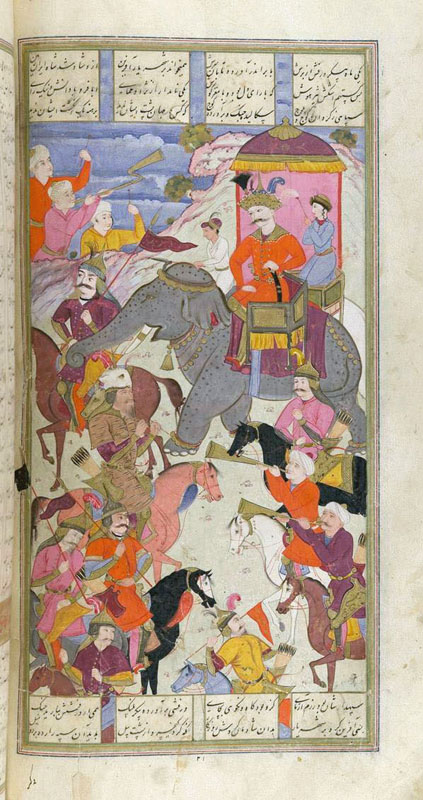Kay Ḵosrow Reviews His Troops
Kay Ḵosrow is seated on a canopied throne aboard the back of a large gray elephant advancing toward the left. In accordance with the text, Kay Ḵosrow wears a jewel encrusted crown, collar, and girdle, but there is no evidence of the bull-headed mace supposed to be on his shoulder. A diminutive dark-skinned Indian driver, about one-third the size of the shah, rides on the neck of the elephant, and a fly-chaser of the same size is seated behind the throne. The elephant is adorned with a large bell around its neck, and rings of jangles on its head and feet. Two mounted warriors with pointed helmets flank the the elephant, and would appear to be Ḵosrow’s guards. Advancing in the same direction from the right foreground are two mounted trumpeters, wearing turbans, who herald the shah’s advance. The shah’s troops represented by five warriors are clustered in a group on the left side. The only identifiable personage in this group is Rostam, clad in his familiar tiger and leopard skin cuirass, who is seated motionless on his horse Raḵš. Three other figures are represented in the upper left, one a turbanned trumpeter, the other two clamoring with small batons from behind the ridge. The setting is a barren sloping hillside that reaches a summit behind Kay Ḵosrow in the upper right. Small bushes grow near the summit, and beyond them on the left is a sky with clouds.
Painting: 27 x 16 cm. There are three lines of four column text above the painting, and two lines below. A rectangular frame encloses painting and text, except on the left side where a single standard protrudes into the margin. Two of the warrior’s faces have been repainted. and there is a tear, on the left side. The only signature is that of Fażl ʿAli, which appears in miniscule characters in the lower right corner. The painting is attributed by Jackson and Yohannan to Fażl ʿAli, and by Robinson to Moʿin with the assistance of Fażl ʿAli. While the general style is that of Moʿin Moṣavver, a close scrutiny of the details reveals another hand. The heads of the horses, the features of Rostam, and many of the other faces are distinctly different from Moʿin's detailing. Thus, it appears that the painting was in some measure executed by an artist in Moʿin’s entourage, most probably the otherwise unknown Fażl ʿAli.
Painting references:
J&Y_1914, p.36 no.22 (not ill.).
Robinson, Cochran4_1972, p.78, no.22 (not ill.).
Cambridge Shahnameh Project
Text references:
Warner, III, pp.31-32; Mohl, II, pp.465-66; Levy, p.109.
Robert Eng
Last Updated: January 27, 2011 | Originally published: June 18, 2003
